Raising the profile of the SEETO Comprehensive Rail Network
Posted: 6 February 2012 | | No comments yet
The European Commission’s proposal on new TEN-T guidelines adopted on 19 October 2011 was welcomed by the Regional Participants, since it includes important achievement of South East European regional cooperation. For the first time, the SEETO (South East Europe Transport Observatory) Comprehensive Network was included in the TEN-T Comprehensive Network maps, which was characterised as one step further towards complete harmonisation with the TEN-T Comprehensive Network and fortification of the SEETO Comprehensive Network’s position of precursor of TEN-T Comprehensive Network in the South East Europe.
The SEETO Comprehensive Network is a one layer multimodal network which provides high level regional interconnections and connections of the Western Balkan with the EU (TEN-T). In its present form, the SEETO Comprehensive Network consists of 6,554km of roads, 4,807km of rails, 17 airports, four rivers, eight inland waterway ports and 10 seaports.
The regional transport network defined in the Memorandum of Understanding (MoU) for the Development of the Core Regional Transport Network was established by seven South East European Regional Participants and the European Commission in order to ensure stability and economic prosperity of South East Europe.
The European Commission’s proposal on new TEN-T guidelines adopted on 19 October 2011 was welcomed by the Regional Participants, since it includes important achievement of South East European regional cooperation. For the first time, the SEETO (South East Europe Transport Observatory) Comprehensive Network was included in the TEN-T Comprehensive Network maps, which was characterised as one step further towards complete harmonisation with the TEN-T Comprehensive Network and fortification of the SEETO Comprehensive Network’s position of precursor of TEN-T Comprehensive Network in the South East Europe. The SEETO Comprehensive Network is a one layer multimodal network which provides high level regional interconnections and connections of the Western Balkan with the EU (TEN-T). In its present form, the SEETO Comprehensive Network consists of 6,554km of roads, 4,807km of rails, 17 airports, four rivers, eight inland waterway ports and 10 seaports. The regional transport network defined in the Memorandum of Understanding (MoU) for the Development of the Core Regional Transport Network was established by seven South East European Regional Participants and the European Commission in order to ensure stability and economic prosperity of South East Europe.
The European Commission’s proposal on new TEN-T guidelines adopted on 19 October 2011 was welcomed by the Regional Participants, since it includes important achievement of South East European regional cooperation. For the first time, the SEETO (South East Europe Transport Observatory) Comprehensive Network was included in the TEN-T Comprehensive Network maps, which was characterised as one step further towards complete harmonisation with the TEN-T Comprehensive Network and fortification of the SEETO Comprehensive Network’s position of precursor of TEN-T Comprehensive Network in the South East Europe.
The SEETO Comprehensive Network is a one layer multimodal network which provides high level regional interconnections and connections of the Western Balkan with the EU (TEN-T). In its present form, the SEETO Comprehensive Network consists of 6,554km of roads, 4,807km of rails, 17 airports, four rivers, eight inland waterway ports and 10 seaports. The regional transport network defined in the Memorandum of Understanding (MoU) for the Development of the Core Regional Transport Network was established by seven South East European Regional Participants and the European Commission in order to ensure stability and economic prosperity of South East Europe.
The main objectives placed by the MoU are: developing the main and ancillary infrastructure on the multimodal SEETO Comprehensive Network; development and implementation of a Multi Annual Plan for the development of the SEETO Comprehensive Network (MAP); harmonising technical standards, regulatory and administrative provisions; promotion and enhancement of local capacities for the implementation of investment programmes; data collection and analysis of SEETO Comprehensive Network transport indicators; and developing and improving connections with the TEN-T Comprehensive Network. According to the provisions of the MoU, SEETO was established to facilitate implementation of the goals set by the MoU, with special focus on the regional planning of transport infrastructure development. In the process of the SEETO Comprehensive Network development, SEETO uses three main tools: Multi Annual Plan for the development of the SEETO Comprehensive Network, SEETIS and soft measures.
Join our free webinar: Rail cyber-security in a time of technological and regulatory transformation
Join our expert panel, including speakers from Nokia and Siemens Mobility, to explore the critical convergence of cybersecurity and 5G rail comms.
Date: 3 Dec | Time: 15:00 GMT
Can’t attend live? No worries – register to receive the recording post-event.
The Multi Annual Plan is a main regional transport planning document published annually by the SEETO Secretariat, which presents conditions and the performance of the SEETO Comprehensive Network as well as a list of the highest regional priority projects and transport policy oriented soft measures. In order to provide necessary analyses and information on transport activities, the South East Europe Information System (SEETIS) was created, which is one of the largest transport infrastructure databases in the region. Considering the fact that construction of infrastructure requires harmonised procedures and standards, common regional transport policy goals are achieved through the involvement of regional authorities in the SEETO processes and SEETO programme of soft measures (e.g. institutional capacity building, regulatory and legal reform). The most important soft measure in the railway sector was the ‘Railway Reform Project’ (under aegis of SEETO) which had three major outcomes: harmonised Network Statement, Regulatory manual for harmonised infra – structure charging regime and railway border crossing framework agreements1.
The SEETO Comprehensive Rail Network
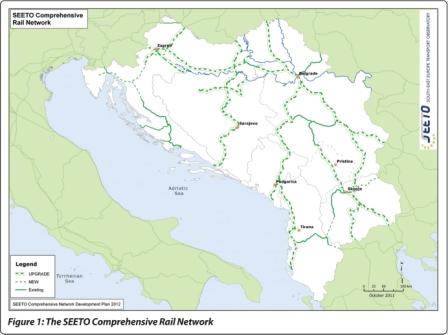

The SEETO Comprehensive Rail Network is composed of 4,807km of railway lines with 2,911km of corridors and 1,896km of routes. Considering that the SEETO Comprehensive Network is a one layer network, division on corridors and routes does not imply any distinction of importance or treatment. Regarding the territorial breakdown of the SEETO Comprehensive Rail Network by Regional Participants, Serbia and Croatia encompass around 60% of the network, followed by Bosnia and Herzegovina with 14% and the former Yugoslav Republic of Macedonia with 12%. When we take a closer look, it is noticeable that Pan European Corridor X with 1,177km has the largest portion of the SEETO Comprehensive Rail Network followed by Route 4 (580km) and Corridor V C (554km). As a solid base for further development of multimodal and intermodal transport in South East Europe, the rail network is directly conn – ected with all SEETO Comprehensive Network IWW ports and with eight out of 10 seaports. So far, 2,807km of the SEETO Compre – hensive Rail Network has been electrified (58% of the entire network), out of which 2,687km is electrified by 25kV/50Hz standard (see below). A small 120km section located on rail Corridor V B in Croatia still operates on 3kV/DC. Nevertheless, it is planned to be electrified with 25kV/50Hz standard.
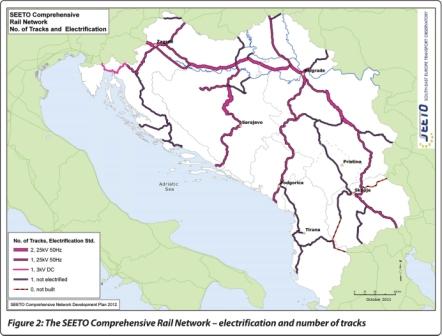

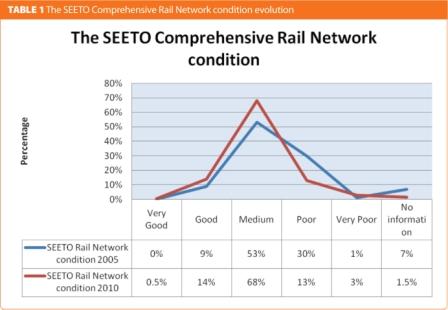

It is worthwhile to mention that the modal shift to less-polluting transport modes such as rail is represented in Regional Participants’ national strategies, expressing their commitment to tackle problems of emissions growth and global warming. One of the main SEETO Secretariat tasks is monitoring the condition of transport infrastructure and its development over the years. Rail infrastructure condition is evaluated by a five point grading scale (the scale ranges from very poor to very good). Condition of the SEETO Comprehensive Network shows improvements over the years due to targeted reduction of sections in poor and very poor condition resulting in its 15% decrease since 2005. Nonetheless, due to the insufficient funding of the rail sector, upgrading and new construction are seldom presented which is reflected on the state of sections in good and very good condition. The evolution of the SEETO Comprehensive Rail Network condition from 2005 to 2010 is presented here: On the subject of traffic flows in South East Europe, it is apparent that the largest portion of passenger and freight transport is allocated on corridors that are serving international and regional traffic and usually provide a higher quality of service. In 2010, Corridor X with a 62% share of pkm and a 36.8% share of tkm was the most significant part of the network in terms of rail traffic volume. Traffic flows on Corridors V B and V C also recorded relatively high traffic volumes, while the highest traffic flows on routes were recorded on Route 4, as presented below. In 2010, a 2% decrease in freight and a 4% decrease in passenger flows on the SEETO Comprehensive Network can be noticed, showing that the market has not completely recovered from the economic crisis. Analysis of the SEETO Comprehensive Rail Network shows that the percentage of capacity used is below 50% which indicates that an EU wide problem of capacity is not the case in the SEETO region. On the SEETO Comprehensive Rail Network, a number of bottlenecks is minor compared to the overall network. Most of the bottlenecks are stationed around the wider area of the Croatian capital of Zagreb, on double and single line sections. In 2010, on Corridor X (Croatia) more than 180 trains per day were recorded at three double line sections in a total length of 60km. Furthermore, one bottleneck was registered on a single line section (total length of 84km) on Corridor X (Croatia). Analyses were performed according to the UIC methodologies and capacity was selected as a key bottleneck criterion, which affirms abovementioned sections as the busiest sections on the SEETO Comprehensive Network. Alongside infrastructure and rolling stock condition, border crossing procedures are impeding rail transport efficiency as well. The South East Europe region has been fragmented in the 90s causing a great number of border crossings to emerge over a short period, which has disrupted transport flows and reduced the competitiveness of rail – ways. The reasons for the delays on border crossings are mostly of an administrative nature. Therefore, in order to make railways more reliable and more competitive, facilitation of border crossing procedures represents a pressing need. Many of the Regional Participants started to cope with this problem by the implementation of Border Crossing Agreements and the establishment of common border stations.
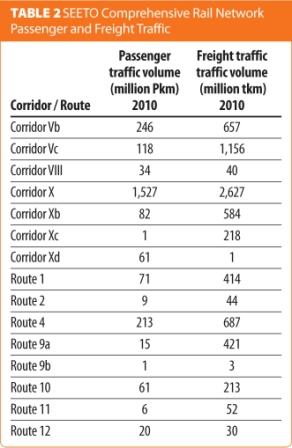

SEETO Comprehensive Rail Network projects
Overall investments implemented on the SEETO Comprehensive Network during period 2005–2010 amounted to approximately €5.698 billion. The investments in the railway sector were €810.89 million (14% of all investments) which are almost six times smaller than in the road sector. It is evident that the SEETO Comprehensive Rail Network requires higher investments in order to be competitive with road transport. Segmentation of investments in the SEETO Comprehensive Rail Network per sources of funding illustrate that the largest support to the railways was registered from the budget resources (49%), followed by International Financial Institutions (IFIs) with 31% of the total share of investments. In relation to the sources of financing, the greatest share of national budget investments was directed to Corridor X (32%) and Route 1 (29%). Investments from the IFIs were concentrated mostly on Corridor X, followed by Corridor V C, where respectively 52% and 23% of the overall IFI funds for railways were placed. Segmentation of investments per Corridors/Routes (see below) showed that the highest amount of investments was directed into Corridor X (€308.083 million) and Route 1 (€223.692 million).
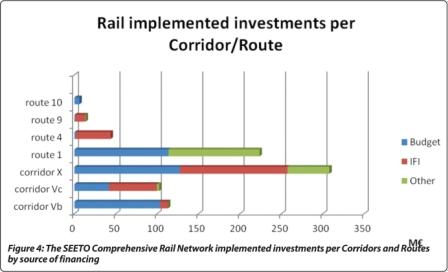

Investments in rail infrastructure development are not adequate compared to the size of the network. Furthermore, mostly standalone sections were developed without considering the whole network improvement, making patchwork effect and failing to fully utilise railway investments. In 2010, maintenance expenditure of seven Regional Participants amounted to €109 million, where 53% were directed to maintenance of infrastructure and the remaining 47% in maintenance of signalling, telecommunication and electrification systems. Concerning the future development plans, in MAP 2012, 35 projects have been selected as regional priorities. The estimated cost for the 35 priority projects is €8.608 billion. Road related projects are requiring the highest investments (70% of total values) followed by rail investment (26%) while 4% is required for other transport modes and terminals. The percentage of priority projects related to ‘environmentally friendly transport modes’ (57% of all projects) shows that the Regional Participants are ready to invest in shifting the balance between transport modes. In this year’s MAP 2012, 10 railway projects are presented in which the status of the project documentation varies; from projects which require financing of project docu – mentation (5) to projects which are ready for implementation (5).
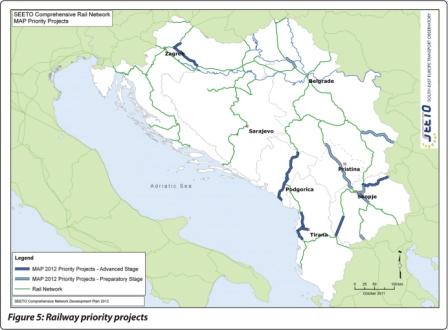

Conclusion
The SEETO Comprehensive Rail Network is a high level regional network and presents a precursor of TEN-T network in the Western Balkan region. For the most part, the SEETO Comprehensive Rail Network has sufficient capacity for present traffic volumes and therefore improvement of utilisation and infrastructure condition is essential in the years to come. The current state of infrastructure requires additional support in investments for the modernisation and upgrading of existing lines, which would (together with the introduction of Border Crossing Agreements and EDI (electronic data interchange)) reduce unnecessary delays and improve the reliability of rail transport flows. For the future development of the rail sector, determining and implementing regional infrastructure priorities, institutional support and establishing a harmonised regional and European approach are prerequisites to ensure a high quality service on the entire network in South East Europe, consequently increasing the attraction of passenger rail travel and to satisfy the increasing needs of the freight market. Due to the region’s attractive geographical position, as a land bridge between Middle East and Western Europe, and its connection to sea ports, river ports and the progressive development of intermodality, South East Europe has great potential to become one of the major trade routes between EU and emerging Asian economies. With the right strategy of development, the railways of the South East Europe region can play one of the pivotal roles in the free movement of passenger and goods.
About the author
Nedim Begović is a railway expert at the South East Europe Transport Observatory (SEETO) and is a graduate of the Faculty of Traffic and Communications (University of Sarajevo, Bosnia and Herzegovina). Nedim has been employed in SEETO since 2010 where he is involved in monitoring the performance of the SEETO Comprehensive Network and the preparation of development plans as well as facilitating the rail reform process in the Western Balkan region.
Global Railway Review Autumn/ Winter Issue 2025
Welcome to 2025’s Autumn/ Winter issue of Global Railway Review!
The dynamism of our sector has never been more apparent, driven by technological leaps, evolving societal demands, and an urgent global imperative for sustainable solutions.
>>> Read the issue in full now! <<<
Issue
Related organisations
South East Europe Transport Observatory (SEETO), TEN-T, Trans-European Transport Network



